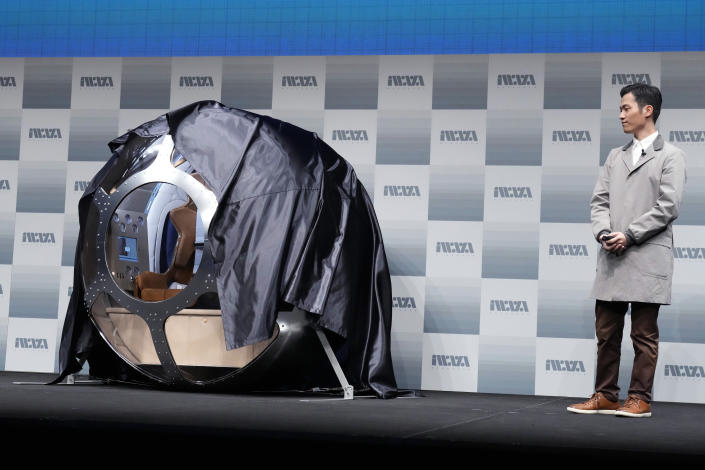U.S. and Russia come together on ISS 'rescue' mission — and 4 more space stories you may have missed this weekBudget space tourism, NASA doubling down on climate and why China’s Mars rover might be busted.Sam Matthews·Executive Producer, Yahoo News
Sat, February 25, 2023 at 11:45 AM EST
Yahoo NewsWelcome to This Week in Outer Space, where you’ll find a roundup of the best space coverage from Yahoo News and our partners from the past week or so. Last week, we took a deep dive into the definitely not alien UFOs that rekindled our curiosity about extraterrestrial life. This week we’ve got black holes behaving badly, some less-than-stellar news about China’s mars rover and more. But first, a tiny glimmer of hope in U.S.-Russia relations:
In space, Russia and the U.S. are still friends (for now)Early this week, while Russian President Vladimir Putin and President Biden traded less than flattering jabs at one another over the war in Ukraine — NASA and its Russian counterpart, Roscosmos, were collaborating on a rescue mission for three crew members stranded aboard the International Space Station. U.S. astronaut Frank Rubio and cosmonauts Dmitry Petelin and Sergey Prokopyev were originally scheduled to return to Earth in the same Russian Soyuz MS-22 capsule they rode up in five months ago. However, a microscopic leak in MS-22’s cooling system, believed to have been caused by a tiny meteorite impact, put the kibosh on those plans.
Desperate for a solution, after some rearranging of the Roscosmos launch calendar, the Soyuz MS-23 “lifeboat” was launched on Thursday to provide a replacement return capsule. If all goes well, Rubio, Petelin and Prokopyev will splash down sometime in March.
However, things still aren’t exactly hunky-dory when it comes to U.S.-Russia relations aboard the ISS, with Russians still set to exit the program by the end of next year.
Things are not looking great for China’s Mars rover Satellite imagery showing the Zhurong Rover, a small blue dot, on March 11, 2022; Sept. 8, 2022; and Feb. 7, 2023. (NASA/JPL-Caltech/UArizona)
Satellite imagery showing the Zhurong Rover, a small blue dot, on March 11, 2022; Sept. 8, 2022; and Feb. 7, 2023. (NASA/JPL-Caltech/UArizona)In other international space news, China’s version of the Mars rover, the Zhurong rover, seems not to be doing a lot of roving. Images captured by the HiRISE camera aboard NASA’s Mars Reconnaissance Orbiter over the last 11 months appear to show that Zhurong’s movements have stalled. Satellite imagery captured between March and September 2022 shows the rover had scuttled about 12 miles from its landing site before coming to a halt — and the latest image from earlier this month shows no additional movement.
It’s not clear when Zhurong stopped moving. The solar-powered rover entered a planned hibernation to ride out the harsh Martian winter in May 2022, but plans to reactivate it in December don’t seem to have panned out. So far, the China National Space Administration has yet to confirm Zhurong’s status.
Black holes keep getting weirderFarther out in deep space, we’ve got a pair of updates for our favorite, slightly terrifying celestial bodies: black holes.
First up, a supermassive black hole at the center of our galaxy appears to be slurping up a giant cloud of dust orbiting around it. The black hole, Sagittarius A, is surrounded by a dust filament about 50 times the mass of the Earth. It's called X7 and has stretched out to a length equal to about 3,000 times the distance between the Earth and the sun. As its 170-year orbit continues, more of X7 is being drawn into Sagittarius A, and astronomers predict that by 2036, X7 may have disappeared completely.
Next, way out at 7.5 billion light-years from Earth, a runaway black hole with a mass 20 million times greater than our sun appears to have been flung from the center of a dwarf galaxy. According to one of the authors of the study that discovered the anomaly, the possibility of a black hole being ejected from a galaxy has been theorized for decades, but this is the first time one has been “unambiguously” observed.
Neither of these things poses an immediate threat to life on Earth. Still, pretty spooky.
NASA sets sights on a planet perfectly suited for life: EarthTurning back to the third rock from the sun, NASA is launching five new missions to study the progression and effects of climate change. New instruments launched into orbit will monitor everything from sandstorms to melting ice caps, with a margin of less than half an inch. NASA and international partners plan to share the data collected with scientists throughout the globe to better understand how our planet is changing and hopefully provide insight into how to slow or, even better, reverse climate change.
Forget about shooting down balloons, how’d you like to ride in one?Finally, a Japanese startup has unveiled plans to offer space viewing tours aboard tiny capsules lifted approximately 15 miles up by the technology that’s been at the center of the international brouhaha of late: really big balloons.
 Keisuke Iwaya, CEO of a Japanese space development company, Iwaya Giken, unveils a cabin for balloon flights. (Eugene Hoshiko/AP Photo)
Keisuke Iwaya, CEO of a Japanese space development company, Iwaya Giken, unveils a cabin for balloon flights. (Eugene Hoshiko/AP Photo)These plans have been in the works for years, and the idea of putting near-spaceflight slightly closer in reach for civilians than hitching a ride with a billionaire is a noble one, but it’s hard to ignore the somewhat unfortunate timing here. February was not exactly a great month for experimental balloons flying high above the Earth’s surface. While these flights would presumably be closely monitored and sanctioned by the appropriate authorities — thus avoiding international intrigue — it’s going to be interesting to see how many people will line up for the $180,000 trips when they launch later this year.
https://news.yahoo.com/space-stories-russia-ukraine-rescue-mission-mars-iss-balloons-164515654.html